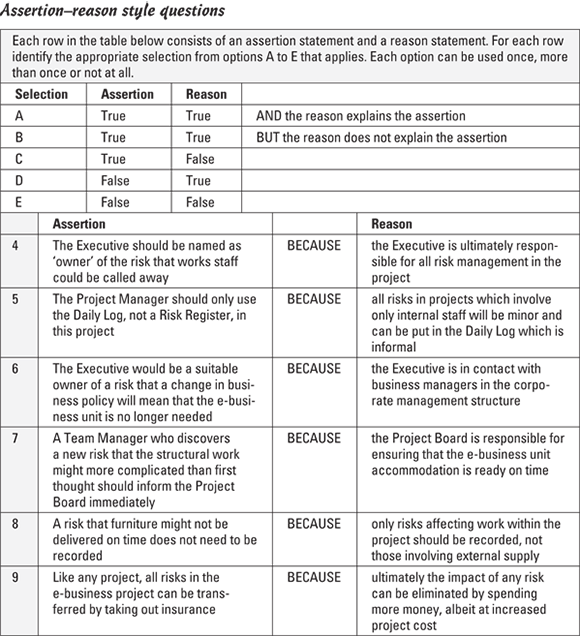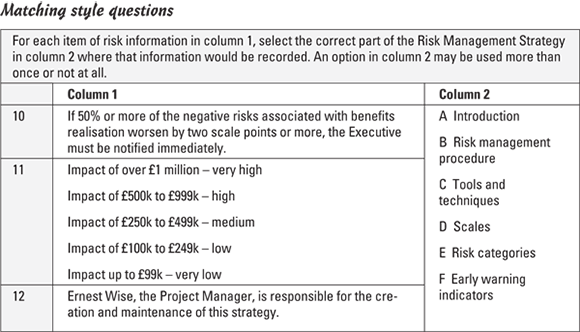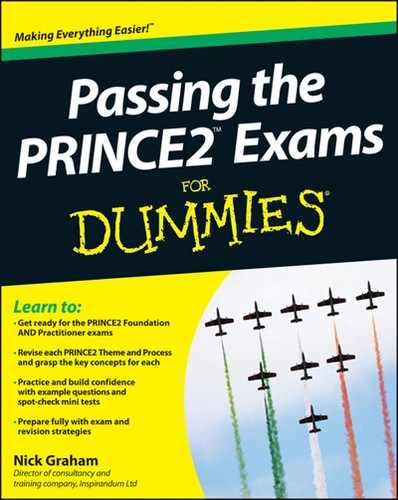Practising With Some Questions
The last section of this chapter has some practice exam-style questions for you to have a go with, preferably to time so that you get used to the pace of the exams. The questions have two purposes: the first is to give you some additional practice, but the second is to make particular points on exam strategy. Those strategy points are explained in the answers that you’ll find at the end of each chapter.
Because books in the For Dummies series are designed for you to dip in to rather than read from cover to cover, I’m going to repeat some advice here in case you’ve not come across it already in the book. That advice is to get hold of the official sample papers available from the exam board, and use them alongside the examples in this book. The sample papers are free, and I’d have been giving you very poor value for money simply to fill this book with them. If you’re attending a training course or doing a distance-learning course, your training provider should give you copies of the official sample papers. If you’re studying alone, look on the APMG website or contact APMG, who run the exams on behalf of the UK Government (which owns PRINCE2).
For the Practitioner exam, you can use the official sample papers as you revise each part of the method, because they cover one section at a time. For the Foundation exam, it’s difficult to use the official sample papers until you’ve learned all of PRINCE2, because questions are random and not grouped by subject. For the Foundation then, I suggest you do the questions in the book as you work through the subject areas, and then do a full sample Foundation paper at the end to get a feel for a full-length exam.
Okay, on with the questions then. You’ll find 10 Foundation-level questions and 12 questions which reflect a couple of the Practitioner styles. You’ll find help in Chapter 2 on dealing with the question styles as well as on overall exam strategy.
Foundation-level questions
Set your timer to eight minutes and try to complete the ten questions within that period. Try to answer the questions without looking at your PRINCE2 manual or any other reference material. If you don’t know an answer to a question, just take your best shot at it and move on to the next one. You’ll find the answers at the end of the chapter, together with a bit of explanation.
1. Which of these is NOT a PRINCE2 risk response?
![]() a) Fallback
a) Fallback
![]() b) Transfer
b) Transfer
![]() c) Share
c) Share
![]() d) Refuse
d) Refuse
2. Which of the following statements is correct?
![]() a) For a given risk, the risk actionee may be the same person as the risk owner.
a) For a given risk, the risk actionee may be the same person as the risk owner.
![]() b) Risk management is optional in PRINCE2 for small and very low risk projects.
b) Risk management is optional in PRINCE2 for small and very low risk projects.
![]() c) No risks can be recorded until the Risk Register is opened.
c) No risks can be recorded until the Risk Register is opened.
![]() d) Team Managers are not involved with identifying risk.
d) Team Managers are not involved with identifying risk.
3. Which term is used in PRINCE2 to describe something that could initiate a risk with a negative impact on objectives?
![]() a) Opportunity
a) Opportunity
![]() b) Trigger
b) Trigger
![]() c) Cause
c) Cause
![]() d) Threat
d) Threat
4. If a team member notices a new risk when working on a Work Package, how does that team member normally report it?
![]() a) Make an entry in the next Checkpoint Report.
a) Make an entry in the next Checkpoint Report.
![]() b) Make an entry in the next Highlight Report.
b) Make an entry in the next Highlight Report.
![]() c) Raise an issue.
c) Raise an issue.
![]() d) Raise a Risk Report.
d) Raise a Risk Report.
5. For risk management to be effective, three things are necessary. Two are that risks need to be identified and controlled. The third need is that risks are:
![]() a) Mitigated
a) Mitigated
![]() b) Recorded
b) Recorded
![]() c) Assessed
c) Assessed
![]() d) Avoided
d) Avoided
6. What are the missing words from the following PRINCE2 definition of risk?
A risk is [?] that, should it occur, will have an effect on the achievement of objectives.
![]() a) A future threat or opportunity
a) A future threat or opportunity
![]() b) An uncertain event or set of events
b) An uncertain event or set of events
![]() c) An identified issue
c) An identified issue
![]() d) A positive or negative circumstance
d) A positive or negative circumstance
7. Which of the following is not part of the PRINCE2 risk management procedure?
![]() a) Identify
a) Identify
![]() b) Plan
b) Plan
![]() c) Resource
c) Resource
![]() d) Communicate
d) Communicate
8. Which of the following statements are correct?
A. Risk tolerance is the level of risk exposure that, when exceeded, will trigger an Exception Report to bring the situation to the attention of the Project Board.
B. In PRINCE2, the Risk Register for a project is created during the process Starting Up a Project.
C. The Project Manager may be designated as the risk owner for one or more risks.
D. The Risk Management Strategy is created and maintained by the Project Manager.
![]() a) A, B and C
a) A, B and C
![]() b) A, B and D
b) A, B and D
![]() c) A, C and D
c) A, C and D
![]() d) B, C and D
d) B, C and D
9. Which of the following are two commonly used measures of a risk?
![]() a) Impact and cost
a) Impact and cost
![]() b) Probability and impact
b) Probability and impact
![]() c) Likelihood and acceptability
c) Likelihood and acceptability
![]() d) Appetite and impact
d) Appetite and impact
10. Which role is ultimately responsible for all aspects of risk management in a PRINCE2 project and to ensure that there’s a Risk Management Strategy for it?
![]() a) Executive
a) Executive
![]() b) Project Manager
b) Project Manager
![]() c) Business Assurance
c) Business Assurance
![]() d) Corporate or programme management
d) Corporate or programme management
Practitioner-level questions
After reading the additional project scenario information, try to answer the questions in this section within 18 minutes. That will mean you’re working at the right pace for the exam. The basic scenario information for the project is at the end of Chapter 2.
Additional scenario
A lot of the work of the project is to be done by the Works Team, a subset of the staff of the Works Department within Princess Projects Plc, and which includes several key people such as the electricians. A common pressure on Works Department staff is being called away from tasks to deal with emergencies. This is fairly common, because the headquarters building is old and prone to problems. Clearly, emergencies usually take priority over project work, because if, for example, there’s an electrical failure, then parts or even all of the headquarters can be affected and everything stops until the problem is located and fixed. It’s not realistic to think that dealing with such emergencies can wait for a day or two until Works Department staff have finished some part of their work on a project.



Answers to the quick quiz
1. Avoid. This response was previously called ‘prevent’, which actually made the action clearer. In this case, if we go by plane, then the train strike can’t affect us.
2. Transfer. The risk impact is being passed to someone else. Sub-contracting is a typical risk transfer action.
3. Transfer. Another transfer, this time covering the financial impact and passing it to an insurance company – albeit at the cost of the premium. Insurance is another typical transfer action.
4. Share. The investment will be shared with a partner in return for sharing the benefit (profit), so it’s a ‘share’ response for an opportunity-based risk.
5. Reduce. The training won’t eliminate (avoid) the risk, but it’ll reduce the chances of mistakes with the consequent impact of project delay.
6. Exploit. There’s a good chance of increased sales, but we’re going to try and make an increase certain with the 10 per cent discount.
7. Reduce. Staff may still lift things incorrectly, but the warning signs will reduce the chance of injury, by reminding staff to use the proper equipment.
8. Accept. The key words here are ‘we’ve decided not to take action’. It’s still in the Risk Register though, first to explain the current inaction, but also so that the risk remains under review; if circumstances change (expectation of good weather), so might the response.
9. Reduce. The lifts are less likely to break down with consequent impact on the schedule.
10. Reject. We still hope that we’ll realise the upside risk, but we’ve judged that it’s not worthwhile to go chasing after it to try to make it more likely.
Answers to the Foundation-level questions
You may have found the practice Foundation questions not tough exactly, but picky. Many questions focus on small points of detail or very exact wording. As you may suspect now as you read this, the approach is entirely deliberate to make a point not just about risk questions but about all Foundation exam questions. Some questions are very picky, to the point that they can be very annoying to some candidates who can’t see why such detail needs to be memorised at Foundation level or how it helps manage projects any better. Indeed, you may be one of those who thinks exactly that – but I, of course, can’t possibly comment. Just take on board the point that you need to be very precise and note the exact terms when you’re revising for the Foundation exam. Forget other approaches to project or risk management and put aside your own organisation’s approach or terminology. Remember that the PRINCE2 exam is about PRINCE2 and only PRINCE2, exactly as written in the manual.
On to the answers then, with some explanation where that might be helpful.
1. d. There’s a response that’s ‘reject’, and unfortunately, perhaps, that also begins with an ‘R’. This is where acronyms such as AS RAFT and SEER serve only as memory joggers, because you still need to remember exactly what the letters of the acronyms stand for. A nasty question, but it’s included here to make the point about being sure of the acronyms.
2. a. Risk management isn’t optional in PRINCE2. Risks identified during Start Up are recorded the Daily Log, even where there’s a clear need to manage them formally. The risks are then transferred to the Risk Register during Initiation, when the Risk Register is then available. Everyone is involved with identifying risk, including Team Managers. Team Managers may also spot risks when doing Team Plans.
3. d. Remember, threats for negative risks, opportunities for positive risks.
4. c. This question shouldn’t have been a problem unless all of the PRINCE2 management products are swimming around in your head and you’re starting to lose focus on what they’re all about. Team members have no part in preparing Checkpoint Reports or Highlight Reports. There’s no such thing as a Risk Report in PRINCE2. If products are starting to swim around, try to stand back a bit in your revision and think at an overview level what each one is for, who prepares it, and how it’s used. You can use the list of products at the start of Appendix A in the manual as a checklist for that revision.
5. c. Sometimes, it seems, question writers are desperate for new material and instead of thinking about what someone at Foundation level needs to know, they just leaf through the manual looking for something – anything – to ask a question about. This time it’s a short list in the manual. However, if you didn’t know that list, you should still have identified the right answer, because the same three elements are in the purpose statement for the Risk theme. [Manual 8.2.3 and 8.1]
6. b. No short cut here. You need to be familiar enough with things like definitions to be able to pick out the correct words quickly and accurately. The key word for risk is ‘uncertainty’, so that’s a good clue here if you weren’t sure.
7. c. Again, rote learning I’m afraid. Watch out for any short list of items such as the risk management procedure used here, for ‘spot the wrong one’ type questions.
8. c. The Risk Register is created during the process Initiating a Project, not during Start Up, and at the time that the Risk Management Strategy is being formulated.
9. b. Another measure is proximity, but that isn’t mentioned in the question. Probability and impact are common measures in risk management generally, not just PRINCE2, hence the P–I Matrix.
10. a. The Executive is ultimately responsible, although others may do risk-related work and have an input. [Manual Table 8-3 Executive responsibility]
Answers to the Practitioner-level questions
Classic-style questions
1. B. Outside PRINCE2, fallback is sometimes called contingency. Either way, it’s allowing for the risk to happen and absorbing the impact, or at least some of it.
2. A. Avoid means that the action will eliminate the risk. If no works staff are on the project because it’s all being done by outside contractors, then works staff being called to deal with emergencies can’t affect the project staffing any more.
3. B. There are two dimensions to risk reduction, and an action may hit on one or both. The first is to reduce the probability of the risk occurring, and the second is to reduce the impact if it does occur. In this case, if ‘preventative maintenance’ is carried out, perhaps the troublesome items will behave themselves, at least mostly, during the project and reduce the number of emergency call outs of the Works staff. It’s certainly worth a try.
Assertion–reason questions
4. D. Team resourcing is the domain of the Senior Supplier on the Project Board, not the Executive, so even if you wanted a board ‘owner’, you shouldn’t go for the Executive.
5. E. Projects need a Risk Register – it’s a key product – and anyway it’s not true that risks related to internal staff will always be minor.
6. A. Even if you don’t know the names of the people in the scenario project, whoever is the Executive is usually a good choice for business risk ownership.
7. D. Team members should normally submit an issue to the Project Manager.
8. E. All genuine risks need to be recorded, and delay to the furniture is indeed a risk.
9. E. You can’t buy your way out of all risk. For example, if the concrete in the building project is faulty and has to be dug out and re-laid, then money isn’t going to make the new concrete set in three minutes flat and so meet the project deadline. Throwing money (risk budget) at them may be a possible action for many risks, but it certainly won’t cover everything.
Matching-style questions
10. F.
11. D.
12. A.
If you’re still a bit unclear on the contents of the Risk Management Strategy, have a look at PRINCE2 For Dummies or Appendix A of the manual – or both. [Manual A24, P2FD Ch15 Understanding the sections of the strategy]
